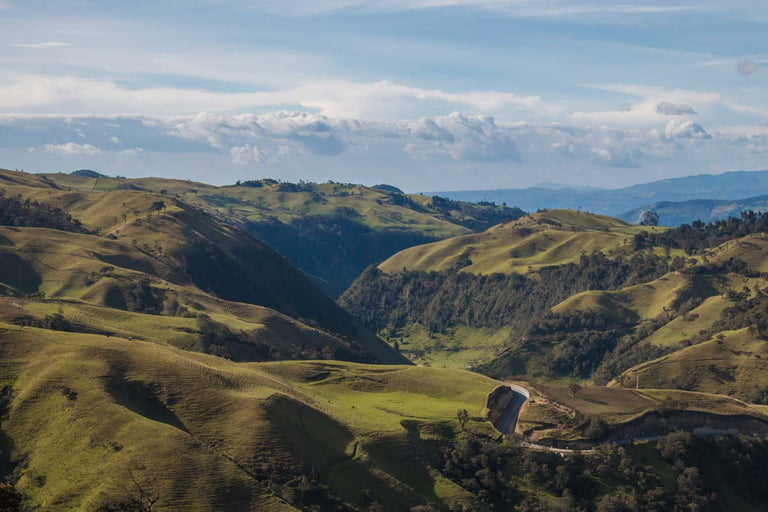A Journey Through the Coffee-Growing Regions of the World and Their Unique Flavor Profiles
By Tyler Workman

Have you ever wondered where your coffee comes from? How the coffee is harvested? Who is behind the coffee?
In an era where many of us want to know where our products come from, how things are made, and who our money is going to, the topic of coffee origin has become quite a popular one amongst many coffee people. There seems to be a genuine desire to know and understand where farmers are growing coffee around the world, what takes place at the farm level and how the farmers produce and process their coffee, and who these farmers are.
Through this month’s blog, I want to embark on a journey with you to answer some of these questions by exploring coffee-growing regions and what makes coffee from these regions so unique. My goal is to help anyone who is interested learn more about the diverse geography of coffee, and to add meaningful value to this drink that we love so much. This topic is so profound that I could probably write a chapter on each of the coffee-growing countries, but for now, we will approach it from more of a general viewpoint.
A look into coffee-growing regions is one fascinating and eye-opening topic. Coffee around the world is mostly grown in a specific area called “The Bean Belt,” which represents the zone along the Equator, between the Tropic of Cancer and the Tropic of Capricorn. Within the Bean Belt, there are three coffee-growing regions: Central and South America, Africa, and Asia.
Within these regions, there are over 50 coffee-producing countries, and they all vary in volumes of production. There are countries like Brazil, Vietnam, and Colombia that amount to more than 50% of global production, and there are countries like Bolivia and Jamaica that produce vastly smaller quantities. Whether the coffee output is large or small, each of these countries matters, and each has its own distinct characteristics and important contributions in the coffee world.
If you thought that the different locations of the coffee-growing countries are the only consideration in what makes coffee so diverse, think again! In each of the regions, the countries have many differing qualities, such as soil and water composition, altitude, microclimates, and coffee varieties. Every single one of these elements contributes to the unique flavor profiles of the regions---and more specifically, of the individual countries within them.
If nutty, chocolaty flavors with caramel tones and a mild acidity appeal to your coffee-loving palate, then coffee from the Americas (Central and South) may be the region for you! Coffee that is reminiscent of dark chocolate, milk chocolate, and cocoa makes sense coming from the part of the world that is home to the treasured cacao plant. Tasters also identify candy, honey, and syrupy notes. Some of the more well-known coffee-growing countries in the Americas include Brazil, Colombia, and Honduras. However, countries like Bolivia, Costa Rica, Ecuador, Guatemala, Honduras, Mexico, Peru, and Venezuela are up-and-coming coffee producers that are gaining reputation---and rightfully so.

Africa is a region where the fruitiest coffees can be found. African coffees have vivid floral, fruity, and berry tasting notes and are characterized by their widely celebrated bright acidity and winey flavor profile. Citrus, bergamot, berries, and jasmine are flavors that are highlighted in these exquisite coffees. As the continent where coffee originated, Africa boasts coffee paradises such as Ethiopia, Kenya, Burundi, Rwanda, and Uganda. With delicate floral aromas like rose, lavender, and honeysuckle, and mouth-watering blackberry, blueberry, and raspberry swirling throughout the various African offerings, it’s easy to see why these coffees are so highly prized in the coffee community.

With over 15 coffee-producing countries---some of the most well-known being Vietnam, Indonesia, and India---Asia is a land of rich, earthy coffees: deeply flavorful spices such as cinnamon, nutmeg, and cardamom, and even chili and pepper. At times, these spicy notes are complemented by a deep chocolate taste and a full body. It’s worth noting that Vietnam and Indonesia are two of the biggest producers of coffee in the world, and Vietnam is in the top three coffee-growing countries, along with Brazil and Colombia. Indonesia’s coffee from the islands of Sumatra and Java is sought after for its much-desired excellence for dark roasting.
I hope this read has inspired you and showed you how fascinating and complex coffee can be. This topic of coffee-growing regions is just a brief glimpse into the world of coffee that will continue to be developed throughout KAHA’s blog series. As a roaster, I place great value in each coffee’s origin and flavor profile when selecting my coffees. The impact that this has on the cup is key to the crafting of KAHA’s blends and single origins that you enjoy so much!


0 comments